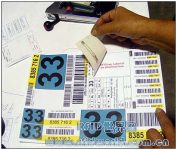
New Zealand Kiwi Fruit Merchants Successfully Obtain ROI from RFID Applications
[ad_1]
The New Zealand company EastPack packs, stores, and ships more than 12 million pallets of kiwifruit to the world every year. The company now uses EPC-compliant RFID tags and readers to track and locate pallets. This project is considered to be one of the largest RFID application projects in the Asia-Pacific region. Three EastPack factories have enabled RFID systems and claimed that the company has already profited from the system in less than a month.
As the RFID system improves the tracking efficiency of pallets, the number of kiwifruits shipped by EastPack in 2008 exceeded 2 million pallets compared to the same period last year. Three weeks after the application, company manager Donna Smit said that the system can accurately locate the position of the pallet most of the time (98.6%).

Paste EPC Gen2 RFID tags on each kiwi fruit tray
“The system has achieved a surprisingly high accuracy rate. I believe we can achieve 100% accuracy in the next few weeks,” Smit said. “The phenomenon of missing pallets has been reduced and search time has been greatly reduced.”
EastPack has 42 cold storage plants in New Zealand, each of which can store 600-700 pallets. The kiwis stored in the refrigerator are sometimes stored for several months before being shipped out.
Knowing the exact position of the tray at any time is very important for EastPack, Smit explained, because some fruit trays have been stored for a period of time and need to be shipped as soon as possible. “We need to shorten the storage time of the fruit as much as possible to avoid the loss caused by the deterioration of the fruit,” she said. “Mastering the exact position of the fruit tray allows us to find the most suitable tray as quickly as possible without having to move a large number of other trays. This increases the efficiency of employees and also means faster order delivery.”
EastPack previously used a bar code system to track pallets, paste bar codes on the pallets, and use the scanner on the forklift to read the bar codes. However, this process depends on the driver’s manual input of the position and arrangement of the pallets. “The problem is,” Smit said, “we can’t guarantee that the driver will enter the information.”
EastPack hires employees seasonally. The maximum working time of employees is 12 weeks, so there is very little time to train them systematically. When the warehouse is particularly busy, many drivers often forget to update the location information of the pallets. EastPack recognized that the company needed more advanced technical solutions to achieve pallet tracking, so they found New Zealand GS1.
Then, New Zealand GS1 senior consultant Erik Sundermann visited the EastPack cold storage plant, recorded the production process, and identified the places where RFID can be applied. “For EastPack, the biggest problem is that kiwifruit is a perishable food. If a tray is missing for a long time, the fruit will rot and become inedible. EastPack also needs to carry out a thorough inventory, because there are different types of fruits. Quality level, some fruits are only for certain markets.
Sundermann learned that if a pallet is not where it should be, the EastPack forklift driver will directly take the other pallets closest to that location and mark the missing pallet. The result is that the company has no way of knowing the number of missing pallets. The challenges faced by EastPack and GS1 are twofold, one is to identify each pallet and its contents, and the other is to determine their location. This requires the confirmation range of the position to be less than half a meter, otherwise the driver will confuse the target pallet with other pallets.
The RFID system provided by Australian RFID hardware supplier Peacock Bros meets both of these requirements. “In order to identify the correct pallet, we installed an EPC Gen 2 RFID reader and antenna on the forklift” Sundermann explained, “The frequency of the pallet tag is 865-868 MHz. When the forklift removes a pallet, the pallet tag is read , The carrying fruit is recognized. A height sensor also determines whether the tray is placed on the top or bottom of the shelf.

EPC Gen 2 RFID reader and antenna are installed on the back of the forklift

The height sensor determines whether the pallet is placed on the top or bottom of the shelf
In order to determine the precise position of the pallet, Peacock Bros also developed a unique 2D barcode printed logo, installed the logo on the ceiling of the cold storage room, and installed a digital camera on the forklift. “The camera is pointed at the ceiling, and when the pallet label is read, the camera captures the barcode on the ceiling,” Sundermann said. “The system decodes the bar code and provides the exact location.” This information is then immediately sent to EastPack’s inventory management system via the wireless infrastructure.

The position of the pallet is judged by the camera on the forklift and the barcode identification on the ceiling
Before installing the RFID system, GS1 and EastPack conducted a proof-of-concept test. “We have full confidence in this RFID system, but because kiwifruit contains a lot of water, we have to confirm that this will not affect the work of UHF tags and readers.”
EastPack conducted a test in five cold storage rooms in June 2007, and the test results proved that the accuracy of the system exceeded 90%. The company claims that the barcode on the ceiling allows the tray to be accurately positioned within 20 cm.
The good test results prompted EastPack to decide to fully implement the system. The company believes that they will soon obtain a return on investment from this system, and plans to further expand the use of RFID technology, such as the use of RFID to track forklifts.
[ad_2]



